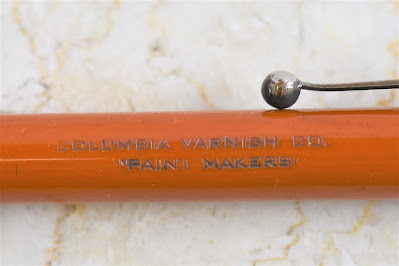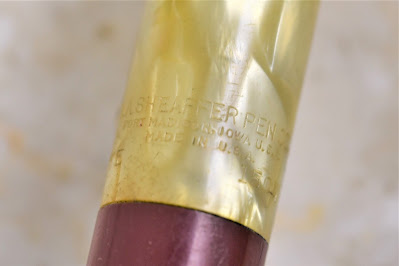This article has been included in The Leadhead's Pencil Blog Volume 7, now available here.
If you don't want the book but you enjoy the article, please consider supporting the Blog project here.
The early development of Sheaffer’s Fineline utility pencils, “in working togs,” is well-documented in Sheaffer’s catalogs. Recently, I found a better home for my crowded Sheaffer archive at an antique mall up in Amish County:
The bulk of my Sheaffer collection formerly resided in that short, gray printer’s cabinet - the move to the larger cabinet on the right gave me a long-overdue opportunity to stretch things out a little bit and reorganize things; time to show how things developed.
Sheaffer’s utility pencil program began in 1936 with the Model LL, a rear-drive pencil with a one-piece barrel. It was cataloged only in black in 1936 and 1937, and in its final year of production, 1938, it was joined by the Model MM, in “grey pearl” (see Volume 5, page 237):
The LL and MM models appear in the 1938 catalog on a page of “Sheaffer’s Regular Pencils.” Another page in the 1938 catalog passes the torch to Sheaffer’s new breed of utility pencils, using “Fineline” .9mm leads supplied by the Joseph Dixon Crucible Company. The “Working Togs” model is shown at the bottom of the page, and the text indicates it was available only in black as Model LE:
Note that Sheaffer’s new model is the only one on this page fitted with a throwback clip, the flat-ball “Sheaffer’s” clip found on Sheaffer’s regular line earlier in the 1930s. Note also a thin metal band separating the top piece from the barrel, a carryover from the earlier MM and LL pencils.
The fact that these were offered only in black for 1938 probably explains why so many more of these are found in that color than any other:
I theorize that all four of these are from 1938, because they also have the ordinary “Sheaffer’s” imprints, another carryover from the LL and MM line:
At the time, “Fineline” was a feature offered by Sheaffer, a slick mechanism for a thinner lead. Sheaffer would soon establish a dedicated “Fineline Division” to manufacture lower-priced and utility pencils. For the 1939 catalog, only “Working Togs” models appear on the “Fineline” page:
Sheaffer’s 1939 catalog indicates that these pencils were now offered in new colors – in addition to the black LE, there were also red, brown, green and blue pencils, somewhat unimaginatively designated RE, BE, GE and . . . well, since brown already took BE the blue was model TE.
No, I haven’t seen a red one yet. A pattern emerges from this small sampling: the colored ones have a “Fineline” imprint on the side opposite from the clip, as opposed to a “Sheaffer’s” imprint below it:
That leads me to believe that black examples, identical to those pictured earlier, were made in 1939 or 1940 when they are found with this Fineline imprint:
Maybe . . . that green example is the exception to the rule, sporting what otherwise appears to be a 1938 imprint.
In 1940, Sheaffer’s catalog illustrates “pearl center” pencils for the first time; note, however, that the pencils illustrated abandon the flat ball clip in favor of a more streamlined version:
“Working Togs” pencils with clips shown in the 1940 catalog remained in production for a number of years with only minor modifications. The black pearl center example second from top was made later, and is included here to illustrate these minor modifications. Sheaffers in 1940-1941 had all gold-filled tips, fully ribbed lower barrels, and that metal band around the pencil at the top of the clip. Later models had two-tone tips, barrels that were only ribbed part way up from the tip, and the metal ring was voided.
At some point Sheaffer decided green should look nicer than the mousy, pea-green in use since 1939. As for the red, white and blue example at bottom, of course those can be “made” by mismatching parts, but “red, white and blue” was specifically cataloged by Sheaffer in 1941, as model IRTE (I for pearl center, R for red, and T – since brown already hogged the letter B – stood for blue) along with one other interesting innovation in the series:
In the lower corner of the 1941 Sheaffer catalog page, illustrating the series, customers were provided the option to have a Sheaffer working togs pencil in either twist (“Turn Type”) or button-activated repeater (“Push Type”). Repeaters were cataloged in solid colors only, given the suffix “J” to the model name (so a black twist pencil was model LE, but a “clicker push type” was LJ).
Brown and blue “clicker push type” pencils have eluded me thus far, but the examples I have provide some good insights:
As mentioned earlier, Sheaffer replaced its ugly pea green with a more attractive, darker green. My example with pea green top and dark green barrel suggests that old parts were being used up around the time the clickers were introduced, in late 1940 or early 1941. The factory demonstrator at bottom is among the finest examples of a demonstrator I’ve ever seen – I believe it came from Don Jacoby’s collection.
Then, that little scuffle known as World War II came along. Sheaffer, along with most other American industries, was called upon to help with the war effort, and product development screeched to a halt. The next Sheaffer catalog in the Pen Collectors of America’s online library is from 1951, and by that time Sheaffer’s Fineline Division was a freestanding enterprise – none of the company’s utility models appear in the catalog. Matt McColm did find an advertisement for a pearl center pencil in The Kiowa (Kansas) News on October 1, 1947:
If the artwork is accurate, the Sheaffer clip was still in use, but it's narrower, like the regular Sheaffer lines were from the era. The two-tone tip had been adopted, the barrel is only partly ribbed, and the metal ring at the top is gone – exactly like the black pearl center pencil shown above.
In February, 1948, Sheaffer’s company magazine,
Sheaffer Review, illustrated the Fineline Division’s new budget fountain pens and pencils, which sported clips imprinted with a script “Fineline” rather than the Sheaffer name. A Sheaffer Fineline brochure in the Pen Collectors of America’s online library and dated June 1951 shows that the clip had been adopted on the Working togs line, as well.
Other clip variations followed, and I illustrated many of them in
The Catalogue. Some lazy Sunday, I’ll try to better refine when these variations were introduced, but for now I’ll leave you with a couple weird variations that don’t fit the norm.
When this article was first published, I thought that the “pearl center” pencils might have been introduced in late 1939, just before the catalog artwork was prepared for 1940, because flat ball clip, pearl center pencils do turn up from time to time:
All of the ones that have surfaced have two-tone tips, barrels that are ribbed about halfway up, and a “W.A. Sheaffer Pen Co.” imprint without the “Fineline” name and with a $1.50 price.
Matt McColm weighed in quickly: the imprint, two-tone tips and partly ribbed barrels are all elements which were not introduced until 1945, Matt said, and I agree with him. These are not an early evolutionary step, but are a much later and inexplicable use of leftover Sheaffer ball clips.
Last (for now) is this pair:
The black example turned up at the Baltimore Show a few years ago. It is a “turn type” with a Fineline imprint and fully ribbed lower barrel, suggesting production in 1939 or later. The other, with a fully ribbed lower barrel and a chrome-plated ball clip – something not seen anywhere in the working togs series – is explained by its imprint.
Made in Canada.
As for the black one, I don’t know . . . that finished cap at the top of the clip rather than an exposed eraser is all that is different about it, so I’m unsure whether it’s factory or whether someone had a bit of fun modifying one. Until some documentation surfaces to explain it, I just enjoy it as a curiosity.



























































